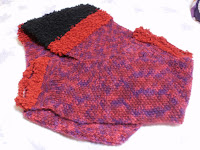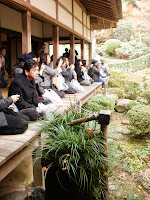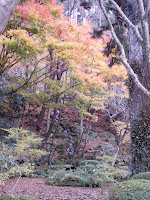The following is my final paper for my Shinto class. It's rather long and catered to its intended audience (the professor), so for those who don't know much about Shinto, it may seem rather vague. Also, if you haven't seen the series Yu Yu Hakusho and plan to, I'd recommend skipping this post because it glides over many plot points and spoils a whole crapton of stuff. Otherwise, enjoy!
I made a power point to go with it; pictures of the slides are at the bottom. Asterisks in the text indicates when to switch to the next slide.
Class after class this past semester, I’ve come away with example after example of Shinto in the series Yu Yu Hakusho. The shonen manga (and anime) created by Yoshihiro Togashi began in 1990 and had a very popular run for a number of years, spawning video games and merchandise still quite easy-to-find today. It follows 14-year-old Yusuke Urameshi’s coming-of-age and exploration of the influences of “other.” This paper will look at the main characters, select minor characters and a handful of themes through a Shinto lens.*
The first scene of the series is that of Yusuke’s death, setting Yu Yu Hakusho with a theme of impurity and the quest to achieve purity. Branded a juvenile delinquent, the character is in tune with Motoori Norinaga, who said “bad people will do a good deed.” Yusuke became a ghost after pushing a small child out of the path of a speeding car—something the workers of the Spirit World didn’t anticipate. The act was so unexpected; there was no place for his soul.
Stuck as a ghost, he was given the opportunity to return to life through a series of trials. The first step was to communicate to the living not to cremate his body, which was accomplished through the invasion of loved ones’ dreams and possession. As a ghost, he was able to accomplish this because “people are more in tune with the Spirit World when they’re asleep” (Botan, ep. 5). The final test continued after he was returned to his body: hatching a Spirit Beast.
Similar to a familiar, the beast was introduced as an egg that would hatch when it had stored up enough energy from its host’s soul. As the incubation process neared its end, Yusuke found himself unable to use his Spirit Energy because the beast was leeching so much of it. In this way, the beast, Puu, represents a parasitic bug. What it would become was also heavily dependent on the quality of the energy; if Yusuke was negative, the beast would become evil. This is equivalent to the mysterious, “other” quality of bugs that give them their unfavorable light.
The delinquent oozed positive energy, though, and Puu emerged as a “blue baby penguin” (Kuwabara, ep. 67). The energy of his soul caused the beast to take the form of a bird. During the series, when Yusuke experienced an increase of power, his Spirit Energy would also take the form of a bird. In class we discussed that when people die, their souls turn into birds. I believe this is Togashi’s subtle method of incorporating that idea, especially due to the fact that when Yusuke dies and is reborn the second time, Puu transforms from the lovable pudge-ball into a phoenix.
Yusuke is quite the picture of a shaman after all his ordeals. His tests include two rebirths, training through austerities and an initiation. Early in the series, he meets an old woman looking for an apprentice to her techniques and is taken as her student. His training includes balancing on spikes, climbing cliff faces with a ball and chain and meditating in a pit of snakes. The final test, or his initiation as her successor, is taking her Spirit Energy into his own body—an extensive and painful process that occurs in the solitude of a cave but gives him unimaginable power after his body accepts it.*
The individual Yusuke possesses while he is a ghost is his rival and eventual best friend Kazuma Kuwabara. He is introduced as a delinquent as well, but one with a softer heart, a code of ethics and the powers of a medium. When ghost-Yusuke is nearby, Kuwabara experiences the “tickle-feeling,” which leaves him paranoid and a bit frightened. He passes it off as an animal spirit but recalls times when he his chased by vengeful onryo.
These encounters with ghosts are what drive him to visit the same old woman Yusuke trained with in hopes of ridding himself of the ability to sense “other” beings, and he undertakes his own austerities that ironically heighten his spirit awareness. After defeating an opponent, he believes he has to inhale the fumes to regain his expended Spirit Energy.
Kuwabara is a simple fellow and one of the few humans in the series. He is often out of his element but is able to make the best of it. In one of his personal “boss battles,” he faces a shape-shifting demon that moves his vitals and liquefies in order to avoid death. Seriously wounded, the demon escapes, only to be fought again, later, after having acquired a human host. This demon resembles another parasitic insect of the series.
In that fight, Kazuma says, “A mulberry is a tree, Kuwabara is a man” (ep. 63). For the longest time, this quote made absolutely no sense. Then I realized it was a translation of his name. As the mulberry itself is the nourishment for silkworms, the emperor bug, descendants of Amaterasu, it can be argued that Kuwabara is a representation of the sun and the people of Japan. He is the least-changed of the characters throughout the series—a human pulled into the “other” who easily accepted its role in his life.*
One of the first demons Yusuke encounters is one named Kurama, an intelligent, soft-spoken thief who appears human. He has a shock of red hair and is often seen wearing a dark pink (or red) school uniform. Add to this the translation of his name, “kept horse,” and it isn’t too much of a stretch to say he represents a plague deity. The demon himself is also a parasite.
Yusuke sees a normal high school student with a sick mother when they first meet. Kurama explains that he “was a fox, a spirit fox,” (ep. 7) who attached himself to a human fetus when he was near death. He parasited off the child until he was able to regain his demonic energy and in the process became attached to his human life. The association with Kurama places his human family under threat of demons and demonic parasites at least three times in the series, a plague of the other world. His step-brother is at one point actually host to a parasite demon. Luckily, Kurama’s power and reputation as a demon protect them.
The spirit fox is differentiated by the name Yoko and represents Inari. Aside from the obvious imagery of the fox, he is a mischievous, tricky thief of knowledge who is in white from head to toe, including silvery hair, ears and tail—which suggest purity and denote the sake and rice Inari presides over. Finally, he uses and has dominion over plants, which represent the agriculture over which Inari is said to supervise.*
Alongside Kurama, Yusuke meets and eventually earns the respect of Hiei, an aloof, vengeful fire demon. Hiei represents the leech child in almost every way, if one ignores Ebisu. His birth was monstrous; born a boy of fire to a village of ice maidens. The very fact he was male confirmed that his mother had coupled with a man rather than reproducing asexually as was the custom. Hiei was deemed dangerous, was thrown off the ice maidens’ levitating island and landed in a river on the demon plane below. He of course vowed to return one day and kill every last one of the women. He did return, but saw them as a frightened, pitiful race and did not extract his revenge, leaving him unappeased. Another step further, his mother died after giving birth to a being of fire—suggesting a connection to Izanami when she died giving birth to the God of Fire.
In Yusuke’s first encounter with the demon, Hiei had stolen an artifact from the Spirit World, a sword which represents that of the Imperial Regalia. The sword was said to have been found in the tail of a dragon. Hiei’s signature attack in the series is the Dragon of the Darkness Flame, a summoning technique that calls a dragon forth to consume the opponent. When he masters the technique, he claims, “I have the power of the black dragon, because now I AM the dragon” (ep. 58). So, Yusuke does technically find the sword with a dragon.*
The old woman Yusuke and Kuwabara train with is the master Genkai. She is both a sanjin, a “great immortal,” and a shamaness. As a sanjin, she is the master others turn to for help. When she uses her Spirit Energy, Genkai reverts to a younger self, when her body was at its most powerful. She lives in a mountain top temple (yes, that’s Buddhist, but I believe that’s where the term sanjin spawned from, and I could write the Buddhism equivalent of this paper anyhow) and has a relaxed yet no-nonsense personality. Reaffirming her “immortal” status, she dies but is returned to life by the lord of the underworld himself. She greets Yusuke, “I died like you. Half-assed” (ep. 66).
As a shamaness, she is shown as able to easily communicate with “others” of Spirit World and of the nature of the Human World. At one point, she looks out over the forest surrounding her temple and can determine where individuals are by picking out the glow of their vital energies. More interestingly, she is able to possess Puu after her death to talk to Yusuke from the Spirit World.
*A bandit buddy from Yoko’s younger days and one of three kings of the Demon World is the ambitious Yomi, who believes there should be no borders between the worlds. He represents the Kojiki tale of the afterlife in yomi, of course. The character is blind, suggesting the darkness within the realm of the dead. All of his political advisers are quite old and ugly, renditions of the hags that chase Izanagi from the land. Within Yomi’s domain, his punishment chambers are shown to be full of gross decay, those within the dungeons falling to pieces and being physically eaten away. Finally, Yomi produces a child without the aid of a woman, his son Shura. This comes from Izanagi’s promise to bring people into the world for each Izanami removes.*
One of Kurama’s opponents in the series is a demon by the name of Ura Urashima, an obvious adaptation of waterboy Urashimataro. In the traditional tale, Urashima is a fisherman who saves a mystic turtle, is rewarded with a trip to an “other” world under the sea and is given a box he is not to open; once opened, smoke from the box unsticks time and makes him age to reflect the time he spent in the other world. In the series, Ura Urashima fights with a fishing pole and carries a box containing smoke that reverts all but the user to infancy. Unfortunately for him, the smoke returns Kurama to his original demon form of Yoko rather than his human infancy.
One of Hiei’s opponents in the series is a demon called Kuromomotaro, similarly an adaptation of waterboy Momotaro. In the traditional tale, Momotaro is born of a peach and fights oni with three companions: a monkey, a pheasant and a dog. In the series, Kuromomotaro buffs himself against attacks by donning three different sets of “Beast Armor,” one of the ape, one of the phoenix and one of the wolf. Unfortunately for him, Hiei wasn’t an oni and hence Kuromomotaro was not able to secure a victory.*
By now, it should be quite apparent this series takes place across a number of worlds: the Spirit World, the Human World and the Demon World. These locations reflect the ideas that there exists a Heavenly Realm, a Worldly Realm and an Underworld. The Human and Spirit worlds are connected by the River Styx. The Demon and Human worlds are connected by something referred to as the pseudo space but kept separate by a kekkai barrier net of energy. Many of Yusuke’s adversaries had the goal to destroy this separation, each for their own reasons, and in the end it is eliminated, but with the law that peace will be maintained. The land of the dead or the realm of afterlife is also shown in the series and is ambiguous as to whether it is in the sea or sky.*
With Hiei, I mentioned the presence of the Imperial Regalia; all three appear as the Artifacts of Darkness in the series. The mirror is called the Forlorn Hope and granted the heart’s strongest desire at the cost of the user’s life. Kurama held the item and wished for his human mother’s continued life. Yusuke didn’t want to see another mother mourn the death of her son and offered himself up as well and the mirror decided to grant the wish without taking any life. The sword is called the Shadow Sword and turned any human cut with its blade into a drone-like demon. The antidote is stored in the hilt. Hiei wielded the item against Yusuke’s love interest and turned the incident into a race to retrieve the antidote. The jewel is called the Orb of Baast and was able to remove the souls of human beings. A demon named Gouki used it to extract the souls of children, which made him something of a tengu.*
There are many instances of bugs in the series and, contrary to what has previously been explored, they are not all parasites. The first instance included a swarm of insects from the Demon World that turned human hosts into aggressive, blue-skinned zombies. They were invisible to humans and both controlled and sustained by a whistle in the Demon World. The second instance was another swarm that overtook Mushiyori city (subtle play on words there, with mushi meaning bug and all). These were mostly harmless and invisible to the normal human being. An individual called the Doctor had his own swarm of psychic insects able to inject humans with a disease fatal within minutes. All these instances show a negative side of bugs that depict them as disgusting and/or dangerous.
That reminds me of a visit I paid to the local shrine next to Hirakatashi station. I had just reached the top of the stairs leading to the shrine grounds and was literally attacked by a visible cloud of mosquitoes. The buggers persisted until the moment I made use of the purification fountain, at which point they were gone. Completely gone. I wasn’t bothered by them again the entire time I was there. It was mysterious and definitely left a sense of the power of “other.”*
Of course, the series is over-run with examples of demons, or yokai. Spectators of the tournaments that take place in the series are mostly human-shaped with glaringly obvious animal and grotesque traits that give the whole ordeal a carnival-like feeling. On Yusuke’s first trip to the Spirit World, he witnesses the bustlingly busy workers of the lord of the underworld: brightly colored, loincloth-clad oni, complete with horns and fangs and the occasional spiked bludgeoning device. His reaction was, “What is this, the dead person stock exchange?” (ep. 2). Yusuke himself is revealed to be a demon, a many-times-over great ancestor to one of the three kings of the Demon World. Adding this aspect to his character and the series’ quest for purity, that Yusuke can exist as both a human and a demon with awareness of the spiritual suggests a balance between the worlds.
While many of the details were made apparent through taking this course on Shinto, viewers in far-off, mostly Shinto-ignorant America are able to pick out aspects of the show that correspond with the native practice. Nicole, a business major at Pacific University, said, “It would be unwise to see Yu Yu [Hakusho] as random in its entirety when most of its spirituality is actually grounded.” She, like many others, acknowledges that religions and spiritualities of Japan, including Shinto, have a heavy representation in the series. Delving a bit deeper, Emi, student at West Valley College, realized that “even the names of characters, abilities and places are […] Shinto references.”
Many Japanese viewers may appreciate the incorporation of these aspects but fail to recognize why because they are so commonplace. Preston, Branham High School graduate, stated his favorite part of the series was the “exploration of duality of justice.” This is true for myself as well. The lines of right and wrong and their importance are quite fuzzy throughout the series. I believe this reflects the nature of the kami. They are neither completely good nor completely evil; simply beings with whims which sometimes cause events to occur that are unfortunate to others.
This course has helped me become more aware of the influence of Japanness on the intellectual properties the country produces. I have become more aware of oddities I experience and have more knowledge of why they are included and play the roles they do. While the question “what is Shinto” may remain unanswerable, at the very least its aspects can be recognized.
-----
Works Cited
Togashi, Yoshihiro. Yu Yu Hakusho. Shueisha. Japan: Tokyo, 1990. 19-volume manga.
English translation by Shonen Jump of VIZ Media.
Togashi, Yoshihiro. Yu Yu Hakusho. Studio Pierriot. Japan: Tokyo, 1992. 112-episode anime. English translation by FUNimation.
And now for the awesomeness PowerPoint. It's 12 slides long.















































































